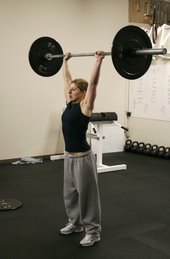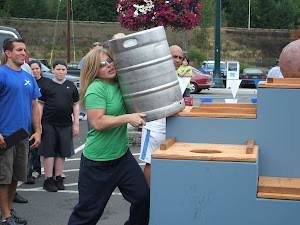". . . . but did the cows look happy?" I asked the Whole Foods butcher after plying him with far more relevant questions concerning the meat displayed. Considering the somewhat cryptic labeling and my complete distrust of the USDA, it's not surprising I'd prefer to go and shake a few hooves and interview my meal face to snout. If you're going to have a trainer and resources that support your healthy lifestyle, your butcher is as much a part of your training team and has as much to do with your athletic performance as I do.
How well we're fed depends on how well our food is fed whether it's nutrient dense soil for our produce or the proper diet for our livestock. We've done some horrendous thinks to our food supply in the name of mass production - none of it good. As a result, our food has become a great jaw exercise with limited value beyond the caloric expenditure of chewing and swallowing.
You've all heard it from me before. The more important thing is you learn a little of the science and find some resources that will help you eat healthier: www.csuchico.edu/agr/grassfedbeef/health-benefits/index.html
Many of you heard the prolonged hunter-gatherer stories including the pursuit of pastured chickens at the farmer's markets and the mucking about in the science of cow's dietary preferences. It included many hours of study and many experiments including my on-going effort to eat food produced within 100ish miles of my decidedly urban homestead. Here's what I found:
There are MANY Farmer's markets and they're a far more reliable resource for 100% grass fed meat. Any steer that's grain-finished will not have the same health benefits. Beware of farms that feed their cows waste such as leftover potatoes. I ran across one of those recently. You'll find suppliers in your neighborhood by first finding your Farmer's Market: www.wafarmersmarkets.com/market_dir.html.
I often shop at the U-District Market on Saturday, but if I'm busy I'll swing by Ballard on Sunday. You can find Samish Bay at both markets http://www.samishbaycheese.com/. The beef tastes spectacular but they feed their pastured eggs whey waste from the cheese production. I'm not so sure if that's healthy (back to the research).
I just ran across Skagit River Ranch. I haven't tasted the beef yet but I'm impressed so far. They have beef, pastured chickens, eggs and pork, and though they're wrapping it up at Ballard this week, they have a store and take bulk orders http://www.skagitriverranch.com/.
For online shoppers, I heard about this source on NPR http://www.tallgrassbeef.com/ and I remember hearing good things about them on the CrossFit message board awhile back. You won't get a chance to shake the farmer's hand but you'll save dollars per pound on the product.
Besides lugging the 20 pounds of Fed-exed meat into the kitchen, you'll need a farm inspired workout to honor your efforts. Here goes, and yes, of course it includes a farmer's walk:
Almost Farming
Virtual Fertilizer Shoveling* www.crossfit.com/mt-archive2/000816.html
45# Plate Snatch** or lower depending on competency
Farmer's walk - length of gym
Dumbbell deadlift with Farmer's Walk weight
Farmer's walk - return length of gym
3 Rounds - 21.15.9 on the Shoveling, snatch and deadlift, distance on the walk
If you haven't done plate snatches, please call for a quick lesson. I couldn't find an example on the web and I haven't done this one with any of you for some time.
*Don't go too heavy on this because it will disrupt the workout if you're at the gym. The clips don't hold very well and you'll have to keep stopping to adjust the plates if you choose a heavy weight.
**The average bale of hay weighs over 47#s and requires a good O-lift to get it on a flatbed. And yes, I spent many summers doing this on my father's farm.
skip to main |
skip to sidebar








A conversation with my clients about exercises, work-outs and nutrition
Search This Blog

About Me
- Heather
- I'm an NSCA-PT and CrossFit certified personal trainer with nine years experience. I hold a purple belt in Brazilian Jiu Jitsu under Marcelo Alonso and Ben Blackstone and I am a Karnataka State Gold Medalist in Weightlifting.

Books
Brain Rules: 12 Principles for Surviving and Thriving at Work, Home, and School Food Politics: How the Food Industry Influences Nutrition, and Health, Revised and Expanded Edition (California Studies in Food and Culture)
Food Politics: How the Food Industry Influences Nutrition, and Health, Revised and Expanded Edition (California Studies in Food and Culture) Good Calories, Bad Calories: Fats, Carbs, and the Controversial Science of Diet and Health (Vintage)
Good Calories, Bad Calories: Fats, Carbs, and the Controversial Science of Diet and Health (Vintage) The Omnivore's Dilemma: A Natural History of Four Meals
The Omnivore's Dilemma: A Natural History of Four Meals Practical Programming for Strength Training
Practical Programming for Strength Training PROTEIN POWER
PROTEIN POWER Secrets of the Soil : New Solutions for Restoring Our Planet
Secrets of the Soil : New Solutions for Restoring Our Planet Starting Strength (2nd edition)
Starting Strength (2nd edition) The Brain Trust Program: A Scientifically Based Three-Part Plan to Improve Memory, Elevate Mood, Enhance Attention, Alleviate Migraine and Menopausal Symptoms, and Boost Mental Energy
The Brain Trust Program: A Scientifically Based Three-Part Plan to Improve Memory, Elevate Mood, Enhance Attention, Alleviate Migraine and Menopausal Symptoms, and Boost Mental Energy Fiber Menace: The Truth About the Leading Role of Fiber in Diet Failure, Constipation, Hemorrhoids, Irritable Bowel Syndrome, Ulcerative Colitis, Crohn's Disease, and Colon Cancer
Fiber Menace: The Truth About the Leading Role of Fiber in Diet Failure, Constipation, Hemorrhoids, Irritable Bowel Syndrome, Ulcerative Colitis, Crohn's Disease, and Colon Cancer The Revolution Will Not Be Microwaved: Inside America's Underground Food Movements
The Revolution Will Not Be Microwaved: Inside America's Underground Food Movements The Zone: A Dietary Road Map to Lose Weight Permanently : Reset Your Genetic Code : Prevent Disease : Achieve Maximum Physical Performance
The Zone: A Dietary Road Map to Lose Weight Permanently : Reset Your Genetic Code : Prevent Disease : Achieve Maximum Physical Performance Twinkie, Deconstructed: My Journey to Discover How the Ingredients Found in Processed Foods Are Grown, Mined (Yes, Mined), and Manipulated into What America Eats
Twinkie, Deconstructed: My Journey to Discover How the Ingredients Found in Processed Foods Are Grown, Mined (Yes, Mined), and Manipulated into What America Eats Mind the Gap: The Science Behind the Sporting Mind
Mind the Gap: The Science Behind the Sporting Mind Extraordinary Knowing: Science, Skepticism, and the Inexplicable Powers of the Human Mind
Extraordinary Knowing: Science, Skepticism, and the Inexplicable Powers of the Human Mind The Subtle Body: An Encyclopedia of Your Energetic Anatomy
The Subtle Body: An Encyclopedia of Your Energetic Anatomy Stumbling on Happiness
Stumbling on Happiness
Products

Blog Archive
-
▼
2006
(16)
-
▼
December
(16)
- 'Is there a problem officer?'
- Blowing your mind but not your arteries . . .
- Be a kid again
- NEAT-O!
- Long Slow Recovery
- Not for the faint of heart
- Down time
- Protein Smack-down!
- Passion on deadline
- No resistance
- Sleeping it off
- What's your function?
- Farm Fueled
- Roped in
- A hamster for the holidays
- Get-up!
-
▼
December
(16)

Resources
- Art DeVany
- Brain Health
- Buy Kettlebells
- CrossFit Eastside
- CrossFit Main Page
- Dr. Cordain's Research
- Dr. Eades
- Dr. Ladd Carlston
- Dr. Randip Singh
- Environmental Working Group
- Food, Farming & Healing Arts
- Get Up! Newsletter
- Health Geek's Wikipedia
- Homework for 10a Class
- Jennifer Adler M.S., C.N.
- Marcelo Alonso BJJ
- Michael Pollan
- O'Lifting Coach Mike Burgener
- Predictably Irrational
- Robb Wolf
- TED: Ideas Worth Spreading
- THIS IS THE PREFERRED MEAL TRACKER
- Tim Ferriss, 4 Hour Work Week


